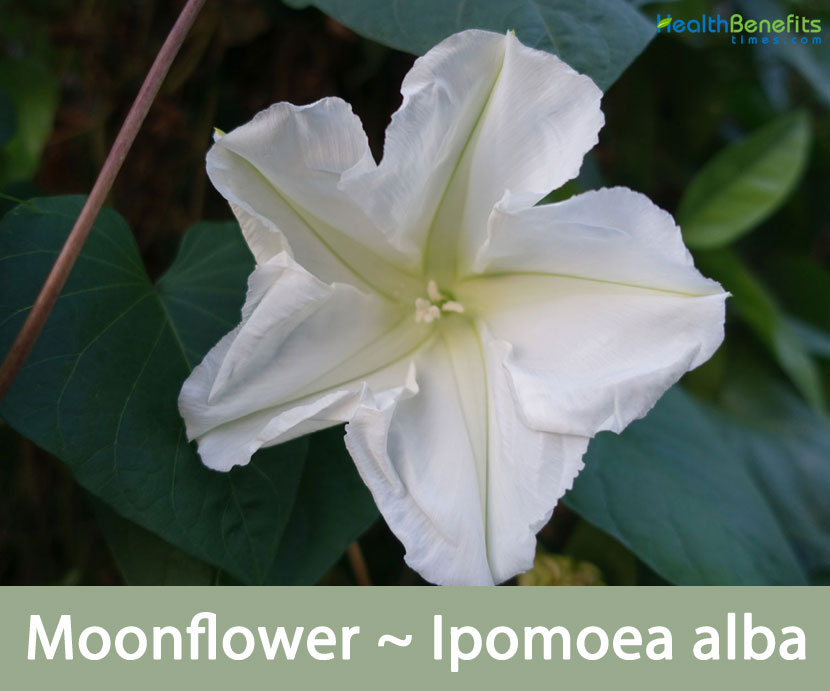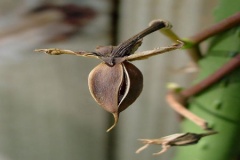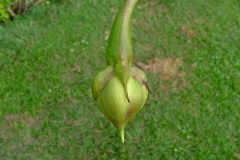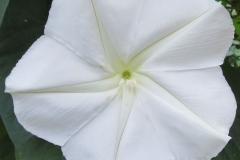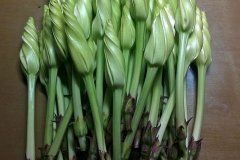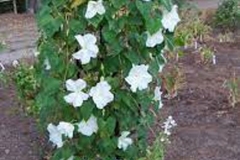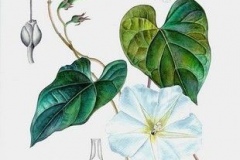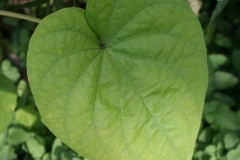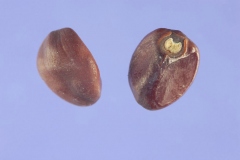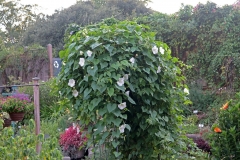| Moonflower Quick Facts | |
|---|---|
| Name: | Moonflower |
| Scientific Name: | Ipomoea alba |
| Origin | Tropical and subtropical regions of North America, Central America , the Caribbean and South America |
| Colors | Initially green turning to dark brown or blackish in color as they mature |
| Shapes | Fleshy capsule, measuring 2 -3 cm long with a pointed tip |
| Health benefits | Beneficial for treating snakebite, filariasis, constipation, boils, wounds, headache and helps in losing weight |
| Name | Moonflower |
|---|---|
| Scientific Name | Ipomoea alba |
| Native | Tropical and subtropical regions of North America (i.e. south-eastern USA and Mexico), Central America (i.e. Belize, Costa Rica, Guatemala, Honduras, Nicaragua and Panama), the Caribbean (i.e. Bahamas, Cuba, the Dominican Republic and Haiti) and South America (i.e. French Guiana, Guyana, Surinam, Venezuela, Brazil, Bolivia, Colombia and Argentina) |
| Common Names | Evening glory; giant moonflower; moonflower vine; tropical white morning glory; white morning glory, moon flower, moon vine, white-flowered morning glory, Good night flower, Prickly Ipomoea, Tropical white morning glory |
| Name in Other Languages | Afrikaans: Maanblom Albanian: Moonflower Amharic: Inijorī (እንጆሪ) Arabic: Zahrat alqamar (زهرة القمر), ‘athman ‘abyad (أثمان أبيض) Armenian: Lusnayin tsaghik (լուսնային ծաղիկ) Assamese: Dudh kolmou Azerbaijani: Ay çiçəyi Bahamas: Moon vine Brazil: Batatarana, boa-noite, bona-nox, cipó-café, dama-da-noite, flor-da-noite, Jetirana-Branca Bengali: Cām̐da phula (চাঁদ ফুল) Bulgarian: Lunno tsvete (лунно цвете) Burmese: Lamainn (လမင်း), Kran-Hing Chamorro: Alaihai-tasi Chinese: Yuè huā (月花), yue guang hua, Tiān jiā er (天茄兒), Yuck Kuang Hua Costa Rica: Buenas noches, dama de noche, flor de la luna Croatian: Mjesečev Cvijet Cuba: Bejuco de la y, flor de la y, flor de la y blanca Czech: Měšíční květina Danish: Moonflower Dominican Republic: Estrella vespertina Dutch: Maanbloem El Salvador: Campanilla blanca, flor de luna, pitoreta English: Moonflower, Tropical white morning-glory, Lilac Bell, White Moonflower, White morning glory, moonvine, morning glory, white-flowered morning glory, Koali-pehu Esperanto: Lunfluo, Blanka ipomeo Estonian: Kuuselill, Kuu-lehtertapp Fijian: Wa ia Filipino: Bulbol Finnish: Kuu kukka French: Fleur de lune, liane bla Georgian: Mtvare (მთვარე) German: Mondblume, Mondblüte, Weiße Prunkwinde, Gute-Nachtblume, stachelige Mondwinde Greek: Nychtoloúloudo (νυχτολούλουδο) Guatemala: Hapolin, luna blanca Gujarati: Mūnaphlāvara (મૂનફ્લાવર) Hausa: Barna Hawaiian: Koali pehu Hebrew: פרח ירח Hindi: Chandr pushp (चंद्र पुष्प), Moonflower Vine, Dudhia kalmi, Naganamukkorai, Evening Glory, Dudhiakalmi (दूधियाकलमी) Honduras: Pañal de niño tripa de gallina Hungarian: Holdvirág Icelandic: Tunglblóm India: Alanga, alangai Indonesian: Bunga bulan, Terulak Irish: Lus na gealaí Italian: Fiore di Luna, fior di note, ipomea spinosa Jamaica: Iight ipomoea, moonflower Japanese: Mūnfurawā (ムーンフラワー), yakai-sōu (ヤカイソウ), yoru-gao (ヨルガオ), yakai-sō, yûgao (ユウガオ) Javanese: Kembang bulan Kannada: Mūn phlavar (ಮೂನ್ ಫ್ಲವರ್), Moon Vine, Candra Pushpa, Chandra pushpa (ಚಂದ್ರಪುಷ್ಪ), Chandrakaanti (ಚಂದ್ರಕಾಂತಿ), Gul chandani (ಗುಲ್ ಚಾಂದನಿ) Kazakh: Ay güli (ай гүлі) Korean: Mun peullawo (문 플라워), bam me kkocc (밤메꽃) Kurdish: Heyv Lao: Dok tauaen (ດອກຕາເວັນ) Latin: Moonflower Latvian: Mēnesspuķe Lesser Antilles: Belle de nuit, fleur de nuit, liane blanche bord de mer Lithuanian: Mėnulio gelė Macedonian: Mesečina (месечина) Malagasy: Moonflower Malay: Bunga bulan Malayalam: Mūṇphlavar (മൂൺഫ്ലവർ), Chandrakanthi, Mandavalli, ipēāmēāya ālba (ഇപോമോയ ആൽബ) Maltese: Fjura tal-qamar Marathi: Chandr phul (चंद्र फुल), Gulchandi (गुलचांदी) Mexico: Nicua, oracion Mongolian: Sarny tsetse (сарны цэцэг) Nepali: Mūnaphlāvara (मूनफ्लावर) Norwegian: Måne blomst Oriya: ଚନ୍ଦ୍ର ଫୁଲ Pashto: سپوږمۍ Persian: گل آفتاب Polish: Kwiat księżycowy Portuguese: Flor da Lua, Batata-brava, Batatarana, Boa-noite, Bona-nox, Cipó-café, Dama-da-noite, Flor-da-noite Puerto Rico: Bejuco de vaca, claro de luna, gloria de la mañana blanca Punjabi: Cana phula (ਚੰਨ ਫੁੱਲ) Romanian: Floarea lunii Russian: Lunnyy tsvetok (лунный цветок), ipomeya belaya (ипомея белая), lunotsvet melkoshipovatyy (луноцвет мелкошиповатый) Serbian: Moonflover (моонфловер) Sindhi: چنڊڀرو Sinhala: San̆da mal(සඳ මල්-) Slovenian: Mesečnica Spanish: Bejuco de Tabaco, camotillo, flor de luna, oracion, bejuco de color blanco, bejuco de vaca, flor de la luna, gloria de la mañana, corneta, Quiebra-cajete Sudanese: Kembang bulan Swedish: Månblomma, Månvinda Tajik: Mokhona (мохона) Tamil: Nilavoḷi (நிலவொளி), Naganamukkorai Telugu: Moonflower (mo͞onˌflou(ə)r), Naagaramukkatte Thai: Dxk chm cạnthr̒ (ดอกชมจันทร์), Chm cạnthr̒ (ชมจันทร์) Turkish: Ay çiçeği Ukrainian: Misyatsya (місяця) Upper Sorbian: Běła wijawka Urdu: چاند پھول Uzbek: Oy gullari Vietnamese: Hoa trăng, Bìm trắng hay tịch nhan Welsh: Blodyn y lleuad Zulu: I-sunflower |
| Plant Growth Habit | Short-lived, fast-growing, old-fashioned, annual or perennial herbaceous liana |
| Growing Climates | Watercourses, riparian areas, moist forests, wet forests, urban bush land and disturbed areas (e.g. in parks, along roadsides, and along railway lines) in the sub-tropical and tropical regions |
| Soil | Grow in moist habitats on sandy and loamy well-drained soil |
| Plant Size | 5–30 m tall with twining stems |
| Stem | Stems are hairless (i.e. glabrous), but the aerial climbing stems sometimes have numerous small projections |
| Leaf | Relatively large leaves are alternately arranged along the stems. They are 5-20 cm long and 4-20 cm wide. They are borne on 5-18 cm long stalks |
| Flowering season | July to August |
| Flower | Large trumpet-shaped flowers have a very long and narrow greenish-white floral tube that is 7- 15 cm long and five large white spreading lobes (10-15 cm wide). They are borne in several-flowered clusters, or occasionally singly, in the leaf forks |
| Fruit Shape & Size | Fleshy capsule, measuring 2 -3 cm long with a pointed tip |
| Fruit Color | Initially green turning to dark brown or blackish in color as they mature |
| Seed | Seeds 8-10 mm long, dark brown |
| Propagation | By Seed and adventitious roots |
| Plant Parts Used | Leaves, root, bark |
| Precautions |
|
Plant Description
Moonflower is a short-lived, fast-growing, old-fashioned, annual or perennial herbaceous liana that normally grows about 5–30 m tall with twining stems. The plant is found growing in watercourses, riparian areas, moist forests, wet forests, urban bush land and disturbed areas (e.g. in parks, along roadsides, and along railway lines) in the sub-tropical and tropical regions. It grows in moist habitats on sandy and loamy well-drained soil. Its stems are hairless (i.e. glabrous), but the aerial climbing stems sometimes have numerous small projections.
Leaves
Its relatively large leaves are alternately arranged along the stems. They are 5-20 cm long and 4-20 cm wide. They are borne on 5-18 cm long stalks (i.e. petioles) and are slightly thick or occasionally even slightly fleshy in nature. These leaves are usually strongly heart-shaped (i.e. cordate) with pointed tips (i.e. acute apices), but can sometimes be slightly lobed.
Flowers
The large trumpet-shaped flowers have a very long and narrow greenish-white floral tube that is 7- 15 cm long and five large white spreading lobes (10-15 cm wide). They are borne in several-flowered clusters, or occasionally singly, in the leaf forks. These flowers open at night, hence the common name “moonflower”, and usually wither by early the next morning. They have five small sepals that are 5-20 mm long with pointed tips and are borne on 7-15 mm long stalks. Each flower has five whitish-coloured stamens and a style that are exerted from the end of the floral tube. The flowers also tend to remain open longer during cool temperatures – which may also cause the segments to snag or tear as they open. Flowering occurs during summer and autumn.
Fruit
Fertile flowers are followed by a small capsule that is 2-3 cm long with a pointed tip. As the fruit matures the flower stalk becomes enlarged, and when fully mature the fruit turns from green to dark brown or blackish in color. It then splits open to release four large, hairless, whitish-coloured seeds that are about 10 mm long.
The Mesoamerican civilizations used the Ipomoea Alba morning glory to convert the latex from the Castilla elastica tree to produce bouncing rubber balls. The sulfur in this morning glory served to cross-link the rubber, a process predating Charles Goodyear’s discovery of vulcanization by at least 3,000 years. Moon Vine is native to American tropics, but has naturalized in many places where it was introduced.
Traditional uses and benefits of Moonflower
- The whole herb is used in treating snakebite.
- Root bark is purgative and leaves used in filariasis.
- Leaves are used as vegetables and also used to cure various diseases in Anjangaon region Dist. Amravati.
- This species of Ipomoea is also known to cure constipation, boils, and wounds.
- In Cameroonian tradition, Ipomoea Alba is used as an anti-diabetic agent, laxative and also improves breast milk quality and helps in losing weight.
- Arial parts are used as anti-pyretic, hypotensive and emollient.
- Leaves used to treat headache.
- Root bark is used as a purgative.
Culinary Uses
- Young leaves and fleshy calyces are consumed after being cooked.
- It is also steamed and eaten as a vegetable or used in curries, soups, stews etc.
- They can also be dried for later use.
- Seed can be eaten when young.
- Fresh leaves of Ipomoea Alba are used as vegetables and also medicines.
Other facts
- Ipomoea Alba has been widely commercialized as an ornamental plant for its showy white flowers.
- In the Caribbean and South America, this species is used as a laxative, fever reducer, as a soap substitute and as food for pigs
- Mesoamerican peoples used the moonflower to convert latex from the Castilla elastica tree to produce bouncing rubber balls.
- In some areas, it is considered an invasive species, and can cause problems in agricultural settings.
Side effects of Moonflower
Listed below is some of the common side effect of using Moonflower
Nervous System Effects
Moonflower consists of several compounds poisonous to the human body, including atropine and scopolamine, which both interfere with the nervous system. The CDC reports that a person who has ingested Moonflower may experience hallucinations, anxiety, confusion and, in some cases, coma. Nervous-system effects generally take place within 1 hour of Moonflower ingestion and may last 24 to 48 hours, according to the CDC.
Hallucinations
Hallucinations from Moonflower may be either visual or auditory. A November 2006 report in “USA Today” titled “Jimson Weed Users Chase High all the Way to Hospital” reports that some people have severe hallucinations and become a threat to themselves or others.
Hyperthermia
Hyperthermia, or high body temperature, may also occur from Moonflower ingestion, as the plant interferes with the body’s ability to cool itself. A person may also experience flushing of the skin and skin that is dry and hot to the touch.
Cardiovascular Effects
Moonflower increases pulse rate and raises blood pressure. The chemical atropine, consists of in Moonflower, may cause cardiac arrhythmia, or an abnormal heart rhythm, which may lead to cardiac arrest, according to a 2002 article in “The Permanente Journal” titled “Jimson Weed Poisoning—A Case Report.”
Prevention and Control
Due to the variable regulations around (de)registration of pesticides, your national list of registered pesticides or relevant authority should be consulted to determine which products are legally allowed for use in your country when considering chemical control. Pesticides should always be used in a lawful manner, consistent with the product’s label.
Physical/Mechanical Control
Seedlings are weak and easy to pull or hoe. Small infestations can be cut near the base of the plant and the roots dug out by hand. For larger infestations with many stems, cutting and subsequent applications of herbicides are required.
Chemical Control
The herbicides 2, 4-D, atrazine, diquat, diuron, glyphosate, oxyfluorfen, pronamide and simazine are recommended for annual morning glory species. For large infestations, the stems can be cut higher up (breast height) causing the upper growth to die. Then the basal stems can be cut closer to the ground, followed by an undiluted (or up to 1: 3 dilution) dose of an herbicide onto the stems.
References:
https://www.itis.gov/servlet/SingleRpt/SingleRpt?search_topic=TSN&search_value=30760#null
http://www.hear.org/pier/species/ipomoea_alba.htm
https://npgsweb.ars-grin.gov/gringlobal/taxon/taxonomydetail?id=20135
https://pfaf.org/USER/Plant.aspx?LatinName=Ipomoea+alba
https://www.cabi.org/isc/datasheet/119823
http://www.missouribotanicalgarden.org/PlantFinder/PlantFinderDetails.aspx?kempercode=c801
https://plants.usda.gov/home/plantProfile?symbol=IPAL
https://en.wikipedia.org/wiki/Ipomoea_alba
http://www.theplantlist.org/tpl/record/tro-8500717
https://indiabiodiversity.org/species/show/230039
http://www.flowersofindia.net/catalog/slides/Moon%20Vine.html
https://keyserver.lucidcentral.org/weeds/data/media/Html/ipomoea_alba.htm
https://gd.eppo.int/taxon/CLYAC
http://tropical.theferns.info/viewtropical.php?id=Ipomoea+alba


